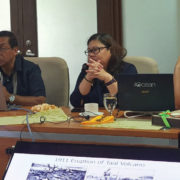Business as usual after Taal Volcano eruption
It is business as usual for most companies operating in the Calabarzon Region (Region IV-A) following the eruption of the Taal Volcano last Sunday, January 12.
“After a temporary disruption of one to two days, our factories in the Calabarzon Region have resumed operations,” Trade Secretary and Board of Investments (BOI) Chairman Ramon Lopez said. “With a resilient Filipino workforce, these companies remain strong and can positively overcome obstacles with the ‘Make It Happen’ mindset,” he said.

“In any situation of natural disasters, of course, the most urgent task is to ensure the safety of the people affected, and in the case of industries and businesses, the safety of its employees,” he said. “But after this, the BOI immediately conducted inspections in the affected industries to get a general assessment of the situation on the ground, taking note of the businesses’ concerns on its employees, utilities such as power and water, and logistics,” Lopez said.
Officials of the Department of Trade and Industry (DTI) and the Board of Investments (BOI) composed of BOI Managing Head Ceferino Rodolfo, BOI Executive Director Ma. Corazon Halili-Dichosa, DTI Region IV-A Assistant Regional Director Marissa Argente, and BOI Director Bobby Fondevilla conducted visits on January 15 to companies based in some of the industrial parks in the Calabarzon Region to get a general assessment of the situation in the areas affected by the eruption of the Taal Volcano.
“It’s mostly business as usual as we aim to ensure operations in Region IV-A remain uninterrupted. We are on standby to help companies in their contingency plans and we will not hesitate to provide relief and support to firms affected by the Taal Volcano eruption.” Undersecretary Rodolfo said.

The DTI and BOI team visited companies in three industrial parks.
Officials of the First Philippine Industrial Park (FPIP) in Sto. Tomas, Batangas informed the DTI and BOI Team that its business as usual in the park and that contingency plans are in place in the instance of worst-case scenarios. Power and water utilities temporarily shut down when the eruption happened.
About 90% of the companies, however, have already resumed operations as of Tuesday, while the remaining 10% will operate once their raw materials arrived, according to the FPIP.
“As a response, these companies conduct three-day inventories and most of them operate on a “just-in-time” system. We also noted they maintain shuttle buses for the safe commute of their workers,” said Executive Director Dichosa.
“The companies also highlighted the importance of accuracy of information gathered from the government agencies and established communication protocols particularly cascading of information from the heads down to the employees,” said Director Fondevilla.
FPIP also informed the team that they are already doing a park-wide clean up of all the debris including the collection of ashfalls from locators which will be given to the barangay for possible other uses such as fertilizers and conversion to hollow blocks.
The team also met with officers of Denso, an automotive parts and components manufacturing company employing around 1,900 employees based at the Carmelray Industrial Park 1 in Calamba, Laguna. During the meeting, Denso informed the Team that their company is up and running and that power and water utilities are not a problem. The company hired an outsourced service provider to clean up the debris in its roof caused by the volcanic eruption. It is also crafting a risk management plan in case of the possibility of the prolonged condition of the Taal Volcano.
Denso officers meanwhile requested BOI’s assistance in coordinating with the Philippine Economic Zone Authority (PEZA) and the Clark Freeport Zone the gateway protocols on the shipping of raw materials.
For its last stop, the DTI and BOI team visited Electronics Manufacturing Services (EMS) Group, an electronic and semiconductor subcontracting group that offers technology and manufacturing solutions located at the Laguna Technopark in Binan, Laguna.
During the meeting, EMS thanked the BOI for the visit, saying that such a gesture is concrete proof that the government is doing its work. The team was also informed that EMS had to temporarily close its operations as the company’s raw materials up to the end products are very sensitive to dust. The company, however, was in full operation as of Wednesday.
The officers of the company also briefed the team on the Risk Management Plan they formulated in case the Taal volcano situation worsens to Alert Level 5. The plan included protocols and assignment of decision authority levels from the head of the company up the cascading of decisions to Business Units and the rest of its 10,100 employees. The plan also included components of the Occupational Safety training as mandated by the Department of Labor and Employment (DOLE).
The DTI and BOI team also met an employee of EMS who shared her personal experience as to the Volcanic eruption in Batangas.
EMS officials meanwhile sought the assistance of the Team in the bulk sourcing of the prescribed face masks for its employees. Undersecretary Rodolfo suggested the possibility of sourcing these masks from Taiwan.
To shed light on the current state and possible scenarios on the Taal volcano eruption, the BOI, in its Joint Board and Management Committee Meeting today (January 16), invited resource experts led by Department of Science and Technology (DOST) Undersecretary for Disaster Risk Reduction and Climate Change Affairs Renato Solidum, and Geo hazard experts Raymond S. Rodolfo and Arlene Mae P. Tengonciang.
Representatives from industry stakeholders led by Bobby Batungbacal were also present in the meeting to provide the industries’ insights and concerns particularly on logistics and utilities given the situation.
Undersecretary Solidum clarified that only business establishments within the 14-kilometer radius of the Taal Volcano Base Surge Hazard Map identified by Phivolcs are required to evacuate.
A base surge is a special class of pyroclastic density currents which are “mixtures of fragmented volcanic particles, hot gases and ash that rush down the volcanic slopes or rapidly outward from a source vent at high speeds”, according to Phivolcs. Base surges are ring-shaped spreading out from the base of the eruption column.
Business establishments can refer to the Bulletins and Advisories being issued by Phivolcs on a regular basis and to https://hazardhunter.georisk.gov.ph/ for the updated hazard areas.
Business establishments outside the 14-kilometer radius are encouraged to have a Contingency Response Plan or Risk Management Plan ready to address the effects/impact of the eruption.
The plan should include the following: Decision/Level of Authority Protocols; Occupational Safety Protocols for Employees; and Recovery and Cleanup Plan (coordination with Local Government Unit (LGU) authorities and park or ecozone administrators on park or zone-wide cleanup).
As a take away from the concerns and insights discussed, Undersecretary Rodolfo said the BOI will mobilize its teams and delivery units to affected industries within and those outside the 14-kilometer radius hazard zone on power, utilities, logistics and a BOI Hotline to handle investor inquiries and concerns.
He said BOI will also be coordinating with toll operators particularly the STAR Toll in Batangas for the bay linking to the South Luzon Expressway and the connectivity of the ports for concerns on the shipping of goods from the affected areas to their respective destinations. BOI is also looking at partnering with the Philippine Institute of Volcanology and Seismology for the geohazard risk maps of industries within the region.
“Even as operations have resumed, we all remain vigilant. We continue to monitor the Taal Volcano’s activity—mainly through the official Phivolcs bulletins, as a guard against fake news—and have enhanced coordination mechanisms with our private stakeholders and government partners. Remember that we are still on Alert Level 4. Of course, in all of our actions, priority is the safety of workers and their families; and then comes Business Continuity,” said Rodolfo.
As a follow-through for these initiatives, the BOI met industry stakeholders, resource persons from the various government agencies on January 21 to discuss businesses and industries’ concerns on utilities, logistics, employee safety, and other relevant topics.
Rodolfo meanwhile underscored the strategic significance of the Calabarzon in the country’s economic growth and national development as it has been the top recipient of approved investments in recent years.
BOI figures show that the Calabarzon region attracted P390 billion or more than a third of the committed investments in 2019 valued at P1.14 trillion.
Batangas, alone, is scheduled to host two colossal power projects worth a total of P95.7 billion, and a natural gas plant costing P35.2 billion.
The Quezon province, on the other hand, will be home to a 1200 MW power plant with a project cost of P130.3 billion and a P47.4 billion wind power project. The region comprises the provinces of Cavite, Laguna, Batangas, Rizal, and Quezon.
The Calabarzon region is the second-largest contributor to the domestic economy, accounting for 17% of the country’s economic output in 2018. The industrial sector dominates the region’s production, accounting for 62% of the gross regional domestic product (GRDP). In 2019, there were 6.2 million employed persons in Calabarzon, the biggest among all regions.







